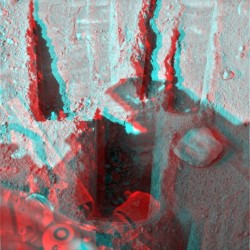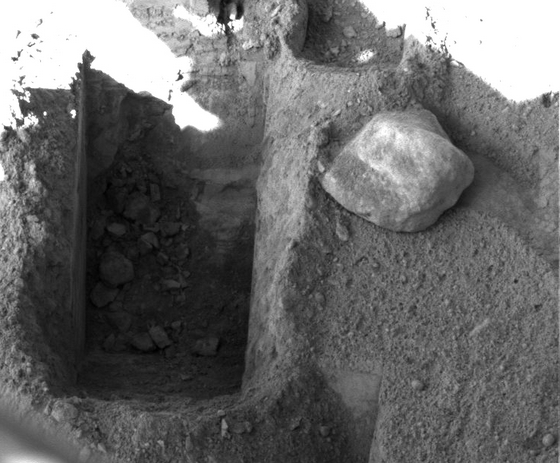[/caption]
The next sample of Martian soil being grabbed for analysis is coming from a trench about three times deeper than any other trench NASA’s Phoenix Mars Lander has dug. On Tuesday, August 26, the scoop on the lander’s robotic arm will pick up a sample of soil from the bottom of a trench called “Stone Soup” which is about 18 centimeters, or 7 inches deep. Tuesday will be the 90th Martian day or sol that the lander has been on the Red Planet, which was the original amount of time set for Phoenix’s primary mission. NASA has extended the mission through September, but the clock is ticking for the plucky little lander and the oncoming winter at Mars’ north polar region.
The soil sample from the deep trench will be delivered into the third cell of the wet chemistry laboratory. This deck-mounted laboratory, part of Phoenix’s Microscopy, Electrochemistry and Conductivity Analyzer (MECA), has previously used two of its four soil-testing cells.
“In the first two cells we analyzed samples from the surface and the ice interface, and the results look similar. Our objective for Cell 3 is to use it as an exploratory cell to look at something that might be different,” said JPL’s Michael Hecht, lead scientist for MECA. “The appeal of Stone Soup is that this deep area may collect and concentrate different kinds of materials.”
Stone Soup lies on the borderline, or natural trough, between two of the low, polygon-shaped hummocks that characterize the arctic plain where Phoenix landed. The trench is toward the left, or west, end of the robotic arm’s work area on the north side of the lander.

When digging near a polygon center, Phoenix has hit a layer of icy soil, as hard as concrete, about 5 centimeters, or 2 inches, beneath the ground surface. In the Stone Soup trench at a polygon margin, the digging has not yet hit an icy layer like that.
“The trough between polygons is sort of a trap where things can accumulate,” Hecht said. “Over a long timescale, there may even be circulation of material sinking at the margins and rising at the center.”
The science team had considered two finalist sites as sources for the next sample to be delivered to the wet chemistry lab. This past weekend, Stone Soup won out. “We had a shootout between Stone Soup and white stuff in a trench called ‘Upper Cupboard,'” Hecht said. “If we had been able to confirm that the white material was a salt-rich deposit, we would have analyzed that, but we were unable to confirm that with various methods.”
Both candidates for the sampling location offered a chance to gain more information about salt distribution in the Phoenix work area, which could be an indicator of whether or not liquid water has been present. Salt would concentrate in places that may have been wet.
While proceeding toward delivery of a sample from Stone Soup into the wet chemistry laboratory, Phoenix is also using its Thermal and Evolved-Gas Analyzer to examine a soil sample collected last week from another trench, at a depth intermediate between the surface and the hard, icy layer.
Original News Source: University of Arizona’s Phoenix News


So they chose to analyze dirt that is probably the same as the other two tests, or they could have risked going for an area that possibly has a salt-rich deposit. I personally would have gone for “the white stuff”.
How would that circulation of material work? I’ve been trying to wrap my head around it since I read the article, but to no avail. I can venture a guess as to how material would sink at the margins (if some of the ice sublimates each summer in the hexagons, gravity would do the trick, I guess), but I can’t think of a way for it to rise back up in the center.
Any ideas?
@Jorge: Wind?
Hm…
Wind could remove the top layer or put extra material in the trough. I can’t imagine how wind could make it actually rise.
But wind could uncover buried stuff, yes. Maybe this is what they meant? Dunno.
Is it going to bury itself?
What about an Invisible alien?
Be imaginative, lol.
Universe has some invisible power anyway 😉
¿COMO ES POSIBLE ESA SUBLIMACION DEL AGUA DE ESTADO SOLIDO A VAPOR, SIN NISIQUIERA GENERAR UN LIGERO RASTRO DE LODO?, ¿EN VERDAD ES AGUA?
EL PHOENIX, DEBIÓ HABER LLEVADO CONSIGO ALGUNAS SEILLAS Y CULTIVARLAS EN MARTE DE MANERA EXPERIMENTAL, ALGO COMO MAIZ, TRIGO, NOPALES, FRIJOL, ETC… ¿PORQUE NO HACEN ALGO ASI?
Er… that Jorge ain’t this Jorge (whose mother tongue isn’t even spanish), and I’d bet that the other Jorge is going to have a tough time getting replies if he asks questions in spanish.
Still, I’m in a good mood, so I’m going to reply to the first one: if you sublimate, you jump from solid to gaseous, without stopping at liquid. The individual molecules simply detach from the ice and become airborne. And since you never become liquid there won’t be any mud, which needs liquid water to form. Mud only appears with melting, not with sublimation.
Anyone goodhearted enough for the second one?
E tu podias por uma inicial à frente do “Jorge”, amigo. Assim torna-se confuso.